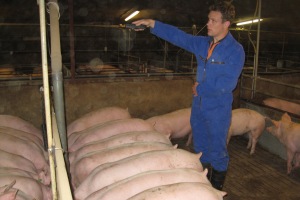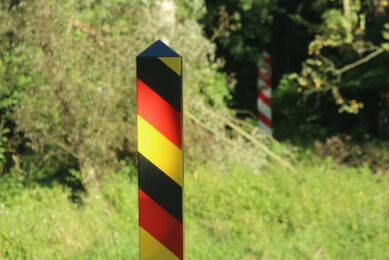EuroTier gold medal for OptiScan mobile pig weighing system

Hölscher + Leuschner’s new innovation OptiScan has received a EuroTier gold medal. The innovation can be seen at the upcoming EuroTier, in Hanover, Germany, 13-16 November.
The OptiScan is a mobile weighing system for fattening pigs that works using three-dimensional camera technology. The handy unit is held over the fattening pig for three seconds at a distance regulated by the camera itself depending on the pig body. With the 3D picture and certain coordinates it is possible to determine the weight of the fattening pig digitally.
Thanks to the device, the physically strenuous and time-consuming weighing of the fattening pigs is no longer necessary. The device improves labour management and does not cause any additional stress to the fattening pigs either. The device allows more precise, weight-related marketing and faster and more animal-kindly weighing operations.
Moreover the upstream and downstream work involved in classic weighing operations, such as cleaning the driving passages and weighing platforms, is no longer required, which in turn means savings in water and disinfecting agents.
Hölscher + Leuschner, Emsbüren, Germany (Hall 12, F46)
Silver award-winners
Several other pig-related innovations received silver medals.
Düsser Rooting Tower
The Düsser Rooting Tower is a further development of existing occupational and enrichment equipment for swine. The tower is a device to keep large groups occupied, for offering variable fibrous rooting or playing materials such as e.g. straw, hay, silage.
The innovative character lies in the structural form of the tower. Through a gap in the floor it is possible for the pigs to actively root out the enrichment material. This corresponds more to the natural rooting behaviour of the animals. A further innovation is represented by the versatile use of differently structured enrichment materials. Thus both long-fibre material and short-fibre material (chips) can be offered through the tower. Through an adjustment option at the device it is possible to steer the quantities selectively. This also improves possible applications in strawless operations.
Landwirtschaftskammer Nordrhein-Westfalen, Münster, Germany (Hall 26, A05b)
Schauer Dryfeed Holding Hopper Batch
With rope pulley and chain conveyor systems the transport pipe can only be filled about 50%, as otherwise the drive resistance of the installation becomes too high and as a consequence the system comes to a standstill. If the return line is not guided via the silo in order to empty residual quantities, this would result in overfilling of the line and hence excessive stress. The feed holder hopper BATCH is supplemented by a short rising auger before the feed is transferred to the conveyor line.
Feed is only unloaded from the silo by the auger from the feed holder hopper when no feed comes back from the return line. The feed is then passed to the conveyor cycle via the auger again. The conveying performance of the transport auger is matched to the transport performance of the dry feeding installation. This rules out any over-filling of the system. Accordingly the line routing of the dry feeding can be executed in a simple circuit without additional deflection corners. The conveyor chain as well as all mechanical parts of the installation are thus treated gently, leading to a longer service life and accordingly bringing distinct financial and labour management advantages.
Schauer Agrotronic, Prambachkirchen, Austria (Hall 12, E35)
Boar stub
Castration of piglets without anaesthetics will no longer be possible in future for reasons of animal welfare.
Consequently boar fattening will become important. In the future it will have to be possible to administer different feed mixes for sows and boars in one compartment in order to exploit optimal feed conversion of the two genders housed separately.
Weda has developed a retrofit set for the control of system types M 16 and 4 PX for liquid feeding systems that work with stub lines. This makes it possible to feed different mixtures one after the other via a stub line as of a live weight of 55 kg. The prerequisite for this is gender-segregated keeping and the quantity of a complete feeding block must correspond to at least twice the content of the stub. Lührs has developed a system for single-pipe dry feeding installations that allows different mixtures to be administered in one compartment.
By installing corner drives that have been developed by the company, the chain can run both clockwise and anticlockwise. A short wait follows after feeding, before the chain is emptied by running it in the opposite direction and a new mixture is then fed to the other gender. Both innovations can be retrofitted at low cost and satisfy today’s requirements.
Weda, Lutten, Germany (Hall 12, B48) and Ringelpietz Circulating Feeding System, Lührs Gerätebau, Rehden, Germany (Hall 12, D63)
SowCheck oestrus detection system
The SowCheck oestrus detection system makes it possible to identify sows on heat in group keeping with a feeding station. An oestrus reflex is triggered in the sow via a number of perception levels (physical, olfactory, acoustic, optical). Sows on heat / returning to oestrus are then selected via the feeding station. The results obtained provide the user with a management aid for managing group keeping of sows optimally. In combination with the SonoCheck device, this unites oestrus detection and ultrasonic detection in a single system.
Big Dutchman Pig Equipment, Vechta, Germany (Hall 11, D21)
BigFarmNet Health Monitoring
The software tool serves to support health monitoring in group keeping of pigs with demand feeding stations. The software documents the sequence of visits and feeding times of individual sows in group keeping on one day and over relatively long periods. Assessment of the daily events is carried out with regard to the entire group. Strong deviations of individual animals indicate a health problem of the sow or return to oestrus. By means of an indication or a report concerning the respective sows, the farmer is supported in his monitoring of the animals and in farm management.
Big Dutchman Pig Equipment, Vechta, Germany (Hall 11, D21) and Justus-Liebig-University Giessen (Hall 26, A16)
Designer Proteins
This is a new approach for optimising amino acid and phosphorous supply in line with animal and performance requirements. Through selective fermentation of different feed proteins, anti-nutritive substances are degraded and phosphorous conversion is improved. Furthermore, the remaining lactic acid bacteria have a probiotic role to play.
By including various algae proteins the possible combinations are expanded considerably. With these developments not only do new prospects for nutrient supplies in line with animal requirements arise, but also distinct effects on the ecobalance of animal production result.
European Protein, Baekke, Denmark (Hall 14, F53)
Anta Phyt BLT
A feed additive on the basis of phytogenic substances and carrier substances with prebiotic action has been developed with flanking scientific research. The product was subjected to an elaborate licensing procedure, and on the basis of its broad spectrum action it promises to show effects on the development of undesirable germs and hence take a key step towards reducing the use of antibiotics. It not only improves animal health, but also makes a major contribution to relieving the burden on the environment.
The product concentrates not only on use in the poultry sector, but with modifications offers a wide range of possible uses for other agricultural productive livestock too.
Dr Eckel, Niederzissen, Germany (Hall 16, D20)
Farm Power Manager
The Farm Power Manager software is a system for monitoring and steering the energy consumption of animal improvement farms and for tariff-dependent cost analyses and consumption predictions. Measured or nominal performance data of any electrical consumers/loads are provided by steering computers in the network to a central computer and can be analysed to find answers to various questions. Data exchange is supported on the basis of the ISO norm ‘IsoAgriNet’.
Big Dutchman International, Vechta, Germany (Hall 9, C24) and Big Dutchman Pig Equipment (Hall 11, D21)
Record amount of submissions
The German Agricultural Society, organiser of EuroTier, received more than 300 submissions, from 182 exhibitors across 23 countries – a show record. Around half of the entries come from exhibitors based outside of host country Germany.
DLG has appointed an independent, international jury committee, comprising industry experts from the UK, Switzerland and Germany, to evaluate all the submissions according to stringent criteria. Five gold medals and 19 silver medals will be honoured at EuroTier 2012. The gold medals will be awarded by DLG President Carl-Albrecht Bartmer on 13 November 2012 at the EuroTier evening, which is held each year to mark the start of the exhibition, and he will be presenting the silver medals in a separate ceremony on the opening day.
Other gold award-winners
Other gold medals went to:
• AeroScalder, Marel Stork Poultry Processing, Boxmeer, Netherlands (Hall 9, F32)
• RumiWatch System, ITIN + HOCH, Liestal, Switzerland (Hall 13, G13)
• GEA DairyProQ, GEA Farm Technologies, Bönen, Germany (Hall 27, D35)
• OptiCow, Hölscher + Leuschner, Emsbüren, Germany (Hall 12, F46)
Related website:
• EuroTier











